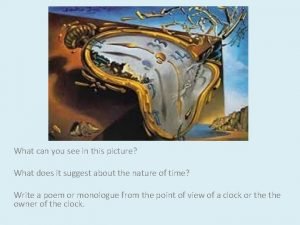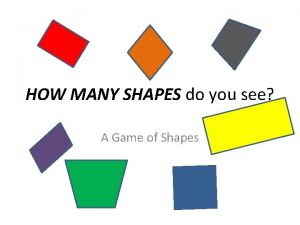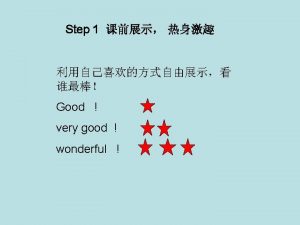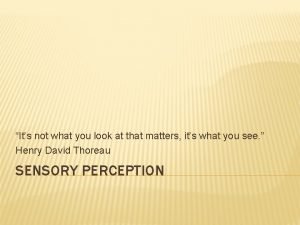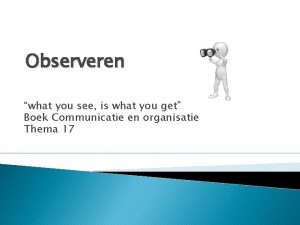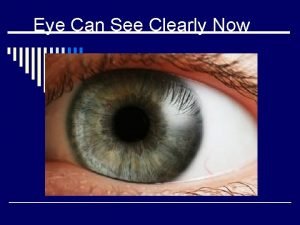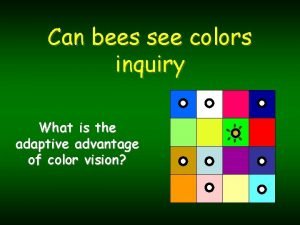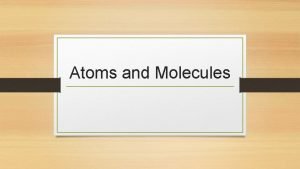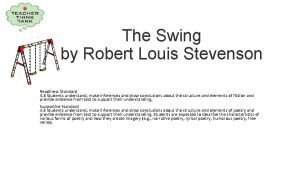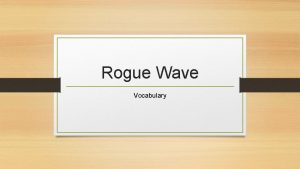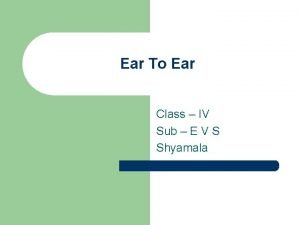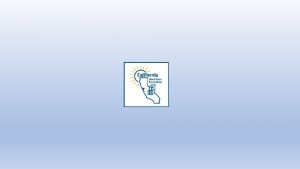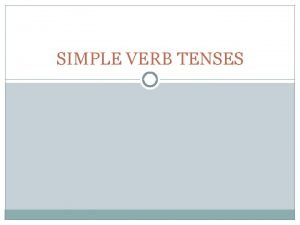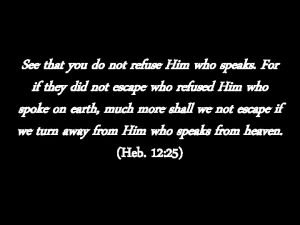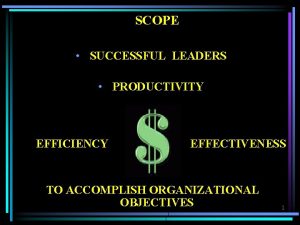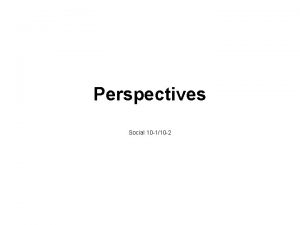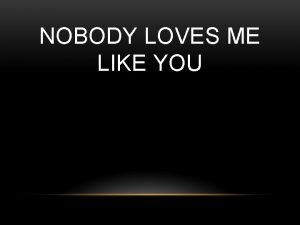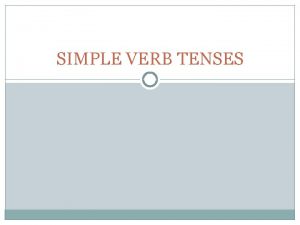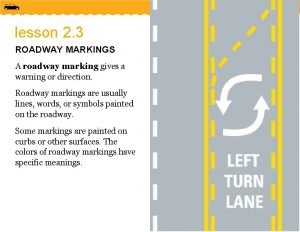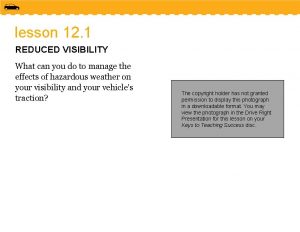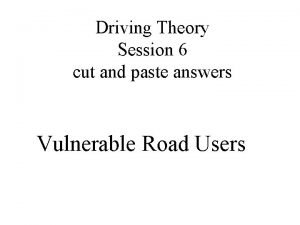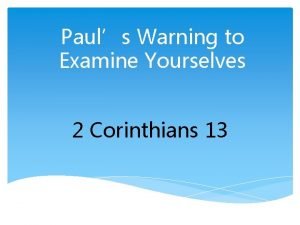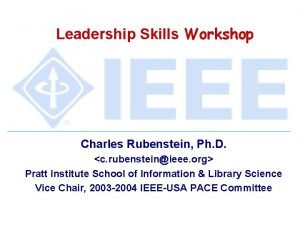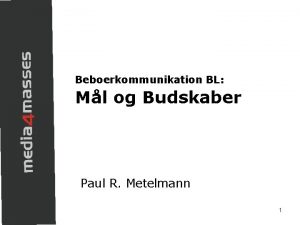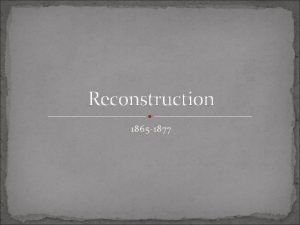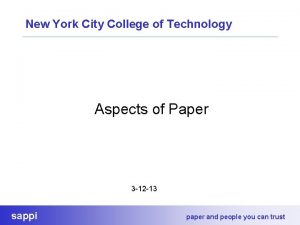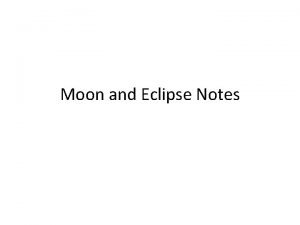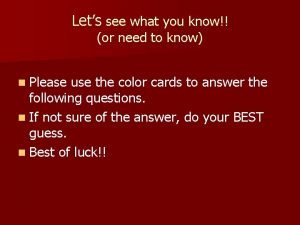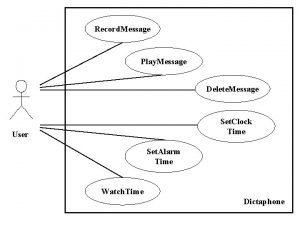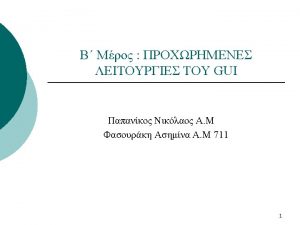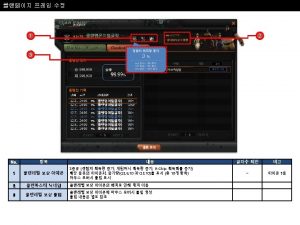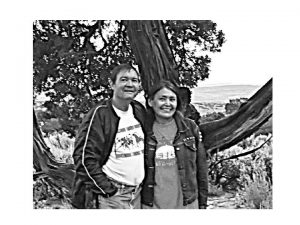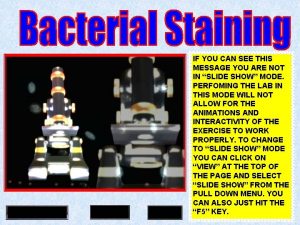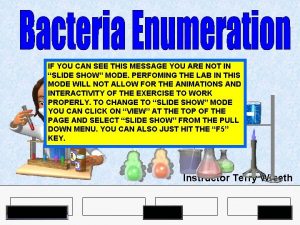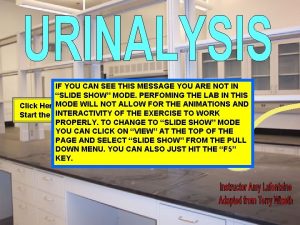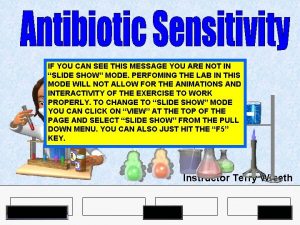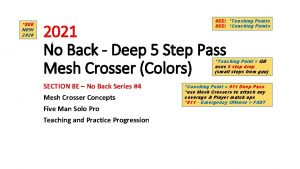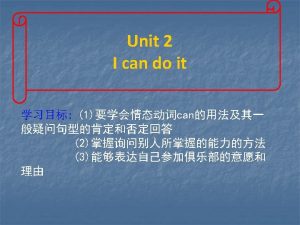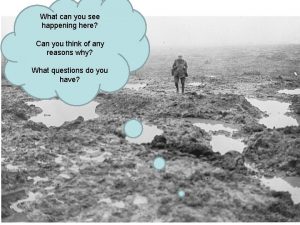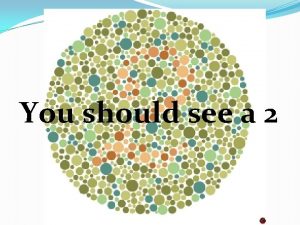IF YOU CAN SEE THIS MESSAGE YOU ARE



























































































- Slides: 91

IF YOU CAN SEE THIS MESSAGE YOU ARE NOT IN “SLIDE SHOW” MODE. PERFOMING THE LAB IN THIS MODE WILL NOT ALLOW FOR THE ANIMATIONS AND INTERACTIVITY OF THE EXERCISE TO WORK PROPERLY. TO CHANGE TO “SLIDE SHOW” MODE YOU CAN CLICK ON “VIEW” AT THE TOP OF THE PAGE AND SELECT “SLIDE SHOW” FROM THE PULL DOWN MENU. YOU CAN ALSO JUST HIT THE “F 5” KEY. Instructor Terry Wiseth

Agar Plates Antiseptic Dispenser Swabs Pencil Microbe Samples Bunsen burner Incubator 37 0 C Loops Click on the blackboard to view a larger board for discussion.

ENUMERATION OF BACTERIA Agar Plates p. H = 7 p. H = 9 As part of daily routine, the laboratory microbiologist often has to determine the number of bacteria in a given sample as well as having to compare the amount of bacterial growth under various conditions. Enumeration of microorganisms is especially important in dairy microbiology, food microbiology, and water microbiology. Knowing the bacterial count in drinking water, fresh milk, buttermilk, yogurt, can be useful in many aspects of industrial microbiology. Bacteria are so small and numerous, counting them directly can be very difficult. Some of the methods used involve diluting the sample to a -10 C the number of bacteria point at which to 35 C has been 50 reduced C 100 very C small numbers. This enables an estimate to be established for quantifying the bacteria. Direct counts of bacteria require a dye to be introduced to the populations of bacteria to allow the observer to view the bacteria. p. H = 11 Freezer 0 p. H = 5 p. H = 3 Refrigerator 0 Incubator 0

Observe three links given below to bring you to the VIRTUAL LAB that you wish to perform. If you have performed all of the exercises, you can click on END LAB. Agar Plates p. H = 7 p. H = 9 p. H = 11 p. H = 5 p. H = 3 Viable Plate Count Freezer Refrigerator Incubator -10 0 C 35 0 C 50 0 C 100 0 C Direct Count Turbidity Count End Lab

VIABLE PLATE COUNT

VIABLE PLATE COUNT Agar Plates p. H = 7 p. H = 9 Viable Plate Count (also called a Standard Plate Count) is one of the most common methods, for enumeration of bacteria. Serial dilutions of bacteria are plated onto an agar plate. Dilution procedure influences overall counting process. The suspension is spread over the surface of growth medium. The plates are incubated so that colonies are formed. Multiplication of a bacterium on solid media results in the formation of a macroscopic colony visible to naked eye. It is assumed that -10 C colony 0 arises C 35 C viable cell. 50 C Total number 100 C each from an individual of colonies is counted and this number multiplied by the dilution factor to find out concentration of cells in the original sample. Counting plates should have 30 -300 colonies at least. Since the enumeration of microorganisms involves the use of extremely small dilutions and extremely large numbers of cells, scientific notation is routinely used in calculations. p. H = 11 Freezer 0 p. H = 5 p. H = 3 Refrigerator 0 Incubator 0

A major limitation in this method is selectivity. The nature of the growth medium and the incubation conditions determine which bacteria can grow and thus be counted. Viable counting measures only those cells that are capable of growth on the given medium under the set of conditions used for incubation. Sometimes cells are viable but non-culturable. Agar Plates p. H = 7 p. H = 9 p. H = 11 p. H = 5 p. H = 3 The number of bacteria in a given sample is usually too great to be counted directly. However, if the sample is serially diluted and then plated 35 out on an 50 agar surface in -10 C C C 100 C such a manner that single isolated bacteria form visible isolated colonies, the number of colonies can be used as a measure of the number of viable (living) cells in that known dilution. The viable plate count method is an indirect measurement of cell density and reveals information related only to live bacteria. Freezer 0 Refrigerator 0 Incubator 0

Normally, the bacterial sample is diluted by factors of 10 and plated on agar. After incubation, the number of colonies on a dilution plate showing between 30 and 300 colonies is determined. A plate having 30 -300 colonies is chosen because this range is considered statistically significant. If there are less than 30 colonies on the plate, small errors in dilution technique or the presence of a few contaminants will have a drastic effect on the final count. Likewise, if there are more than 300 colonies on the plate, there will be poor isolation and colonies will have grown together. Generally, one wants to determine the number of (colony forming units) CFUs per milliliter (ml) of sample. To find this, the number of colonies (on -10 C 35 C 50 C 100 C a plate having 30 -300 colonies) is multiplied by the number of times the original ml of bacteria was diluted (the dilution factor of the plate counted). For example, if a plate containing a 1/1, 000 dilution of the original ml of sample shows 150 colonies, then 150 represents 1/1, 000 the number of CFUs present in the original ml. Therefore the number of CFUs per ml in the original sample is found by multiplying 150 x 1, 000 as shown in the formula given on the next page. Agar Plates p. H = 7 p. H = 9 p. H = 11 Freezer 0 p. H = 5 p. H = 3 Refrigerator 0 Incubator 0

CFUs per ml of sample = Agar Plates The # of colonies X The dilution factor of the plate counted p. H = 7 p. H = 9 p. H = 11 p. H = 5 p. H = 3 In the case of the example given on the previous page: 150 x 1, 000 = 150, 000 CFUs per ml At the end of the incubation period, select all of the agar plates containing between 30 and 300 colonies. Plates with more than 300 colonies cannot be counted and are designated too numerous to count (TNTC). Plates with fewer than 30 colonies are designated too few to count (TFTC). Freezer Refrigerator Incubator -10 0 C 35 0 C 50 0 C 100 0 C

PROCEDURE: VIABLE PLATE COUNT Agar Plates p. H = 7 p. H = 9 We will be testing four samples of water for the Viable Count. The samples include: p. H = 11 p. H = 5 p. H = 3 1) Water from a drinking fountain 2) Boiled water from a drinking fountain 3) Water from the local river 4) Boiled water from the local river Freezer Refrigerator Incubator You will need DATA TABLE 1 to input your data and calculate -10 C CFU per ml. Use the. C number 0 of given below to access 35 link C 50 C 100 C a printable version of DATA TABLE 1. 0 0 0 DATA TABLE 1 0 0

1) Take 6 dilution tubes, each containing 9 ml of sterile saline. 2) Dilute 1 ml of a sample by withdrawing 1 ml of the sample and dispensing this 1 ml into the first dilution tube. 3) Using the same procedure, withdraw 1 ml from the first dilution tube and dispense into the second dilution tube. Subsequently withdraw 1 ml from the second dilution tube and dispense into the third dilution tube. Continue doing this from tube to tube until the dilution is completed. Agar Plates p. H = 7 p. H = 9 p. H = 11 p. H = 5 p. H = 3 Freezer Refrigerator Incubator -10 0 C 35 0 C 50 0 C 100 0 C

4) Transfer 1 ml from each of only the last three dilution tubes onto the surface of the corresponding agar plates. 5) Incubate the agar plates at 37°C for 48 hours. 6) Choose a plate that appears to have between 30 and 300 colonies. Agar Plates p. H = 7 p. H = 9 p. H = 11 p. H = 5 p. H = 3 Freezer Refrigerator Incubator -10 0 C 35 0 C 50 0 C 100 0 C

7) Count the exact number of colonies on that plate 8) Calculate the number of CFUs per ml of original sample as follows: CFUs per ml of sample Agar Plates p. H = 7 p. H = 9 p. H = 11 p. H = 5 p. H = 3 = The # of colonies X The dilution factor of the plate counted Freezer Refrigerator Incubator -10 0 C 35 0 C 50 0 C 100 0 C

Agar Plates Antiseptic Dispenser Swabs Pencil Water Samples Loops Sterile Dilution Tubes Bunsen burner Eye Droppers Incubator Click on the DILUTION TUBE rack of test tubes to bring them to the table. Each of the dilution tubes contain 9 ml of sterile saline solution. Next Click on the WATER SAMPLES to bring the samples to the table. Now Click on the Eye Droppers to withdraw 1 ml of sample #1 (Fountain Water) and dispense this to the first dilution tube. Click on NEXT when this initial transfer is finished. 37 0 C 1 2 3 4 5 Sam ountain ple #1 F 6 Water

Agar Plates Antiseptic Dispenser Swabs Pencil Water Samples Loops Sterile Dilution Tubes Bunsen burner Eye Droppers Incubator Click again on the EYE DROPPER to withdraw 1 ml from the first dilution tube and dispense into the second dilution tube and subsequently withdraw 1 ml from the second dilution tube and dispense into the third dilution tube. Continue doing this from tube to tube until the dilution is completed through dilution tube #6. Click on NEXT when the dilutions are complete. 37 0 C 1 2 3 4 5 Sam ountain ple #1 F 6 Water

Agar Plates Antiseptic Dispenser Swabs Pencil Water Samples Loops Sterile Dilution Tubes Bunsen burner Eye Droppers The dilutions for each of the 6 dilutions tubes can be summarized in the image below. Dilution tube #1 has a 1/10 dilution with a dilution factor of 10. The dilution factor for each of the tubes is listed below. Tube #1 = 10 Tube #2 = 100 Tube #3 = 1000 Tube #4 = 10, 000 Tube #5 = 100, 000 Tube #6 = 1, 000 Click on NEXT when you are ready for the next step in the exercise Incubator 37 0 C 1 2 3 4 5 Sam ountain ple #1 F 6 Water

Agar Plates Antiseptic Dispenser Swabs Water Samples Pencil Loops Lactose Broth Culture Tubes Bunsen burner Eye Droppers Incubator Next we will be inoculating agar plates with the last three broth culture dilutions. Click on the agar plates on the shelf to bring them to the table. Now click on the EYE DROPPERS to transfer 1 ml of dilution #4 to plate # 1, 1 ml of dilutions #5 to plate #2 and 1 mil of dilution #6 to plate #3. Next click on the pencil to label agar plate #1 with a dilution factor 10, 000; plate #2 with a dilution factor 100, 000 and plate #3 with a dilution factor 1, 000. Click on NEXT when finished. 37 0 C 10, 000 1 2 3 100, 000 1, 000 4 1 2 3 4 5 Sam ountain ple #1 F 6 Water

Agar Plates Antiseptic Dispenser Swabs Water Samples Pencil Loops Lactose Broth Culture Tubes Bunsen burner Eye Droppers Incubator Click on the agar plates to place them in the incubator at 37 0 C for 48 hours. We will now need to perform these same dilution and inoculation steps for each of the test samples. The process is the same for each sample and we will assume the process of dilution and inoculation has been completed for all four of the water samples and the 48 hours of incubation time has now been completed. Click on NEXT when you are ready to view the incubated plates. 370 C 10, 000 1 2 3 100, 000 1, 000 4 1 2 3 4 5 Sam ountain ple #1 F 6 Water

Click on the incubator to bring all of the inoculated agar plates to the table. Each of the groups of inoculated plates is labeled with the source of their respective samples. A key for the sample #s is given below. Click on one of the sample groups to view the bacterial growth of the individual dilutions. Agar Plates Antiseptic Dispenser Swabs Water Samples Pencil Loops Lactose Broth Culture Tubes Bunsen burner Eye Droppers Incubator #1 370 C #2 #3 #4 1) Fountain Water 2) Boiled Fountain Water 3) River Water 4) Boiled River Water

10, 000 Sample 1 Viable Plate Count 1, 000 100, 000

You are viewing the agar plates that were inoculated with FOUNTAIN WATER. Click on each of the three inoculated agar plates to view the bacterial colony growth. Count the number of colonies that are present and enter the data in DATA TABLE 1. If the count is less than 30 colonies, the notation will be “TFTC”. If the count is more than 300 colonies, the notation will be “TNTC”. Agar Plates Antiseptic Dispenser Swabs Water Samples Pencil Loops Lactose Broth Culture Tubes Bunsen burner Eye Droppers 1) Fountain Water 2) Boiled Fountain Water 3) River Water 4) Boiled River Water Incubator #1 #2 #3 #4 370 C Click here if you have viewed all the agar plates from all four of the samples 10, 000 100, 000 1, 000

You are viewing the agar plates that were inoculated with FOUNTAIN WATER. Click on each of the three inoculated agar plates to view the bacterial colony growth. Count the number of colonies that are present and enter the data in DATA TABLE 1. If the count is less than 30 colonies, the notation will be “TFTC”. If the count is more than 300 colonies, the notation will be “TNTC”. 10, 000 Agar Plates Antiseptic Dispenser Swabs Water Samples Pencil Loops Lactose Broth Culture Tubes Bunsen burner Eye Droppers Incubator #2 #3 The dilution factor for the plate you are viewing is 10, 000. #4 370 C Click here if you have viewed all the agar plates from all four of the samples 10, 000 100, 000 1, 000

You are viewing the agar plates that were inoculated with FOUNTAIN WATER. Click on each of the three inoculated agar plates to view the bacterial colony growth. Count the number of colonies that are present and enter the data in DATA TABLE 1. If the count is less than 30 colonies, the notation will be “TFTC”. If the count is more than 300 colonies, the notation will be “TNTC”. 100, 000 Agar Plates Antiseptic Dispenser Swabs Water Samples Pencil Loops Lactose Broth Culture Tubes Bunsen burner Eye Droppers Incubator #2 #3 The dilution factor for the plate you are viewing is 100, 000. #4 370 C Click here if you have viewed all the agar plates from all four of the samples 10, 000 100, 000 1, 000

You are viewing the agar plates that were inoculated with FOUNTAIN WATER. Click on each of the three inoculated agar plates to view the bacterial colony growth. Count the number of colonies that are present and enter the data in DATA TABLE 1. If the count is less than 30 colonies, the notation will be “TFTC”. If the count is more than 300 colonies, the notation will be “TNTC”. 1, 000 Agar Plates Antiseptic Dispenser Swabs Water Samples Pencil Loops Lactose Broth Culture Tubes Bunsen burner Eye Droppers Incubator #2 #3 The dilution factor for the plate you are viewing is 1, 000. #4 370 C Click here if you have viewed all the agar plates from all four of the samples 10, 000 100, 000 1, 000

10, 000 Sample 2 Viable Plate Count 1, 000 100, 000

You are viewing the agar plates that were inoculated with BOILED FOUNTAIN WATER. Click on each of the three inoculated agar plates to view the bacterial colony growth. Count the number of colonies that are present and enter the data in DATA TABLE 1. If the count is less than 30 colonies, the notation will be “TFTC”. If the count is more than 300 colonies, the notation will be “TNTC”. Agar Plates Antiseptic Dispenser Swabs Water Samples Pencil Loops Lactose Broth Culture Tubes Bunsen burner Eye Droppers 1) Fountain Water 2) Boiled Fountain Water 3) River Water 4) Boiled River Water Incubator #1 #2 #3 #4 370 C Click here if you have viewed all the agar plates from all four of the samples 10, 000 100, 000 1, 000

You are viewing the agar plates that were inoculated with BOILED FOUNTAIN WATER. Click on each of the three inoculated agar plates to view the bacterial colony growth. Count the number of colonies that are present and enter the data in DATA TABLE 1. If the count is less than 30 colonies, the notation will be “TFTC”. If the count is more than 300 colonies, the notation will be “TNTC”. 10, 000 Agar Plates Antiseptic Dispenser Swabs Water Samples Pencil Loops Lactose Broth Culture Tubes Bunsen burner Eye Droppers Incubator #1 370 C Click here if you have viewed all the agar plates from all four of the samples #3 The dilution factor for the plate #4 you are viewing is 10, 000 100, 000 1, 000

You are viewing the agar plates that were inoculated with BOILED FOUNTAIN WATER. Click on each of the three inoculated agar plates to view the bacterial colony growth. Count the number of colonies that are present and enter the data in DATA TABLE 1. If the count is less than 30 colonies, the notation will be “TFTC”. If the count is more than 300 colonies, the notation will be “TNTC”. 100, 000 Agar Plates Antiseptic Dispenser Swabs Water Samples Pencil Loops Lactose Broth Culture Tubes Bunsen burner Eye Droppers Incubator #1 370 C Click here if you have viewed all the agar plates from all four of the samples #3 The dilution factor for the plate #4 you are viewing is 100, 000. 10, 000 100, 000 1, 000

You are viewing the agar plates that were inoculated with BOILED FOUNTAIN WATER. Click on each of the three inoculated agar plates to view the bacterial colony growth. Count the number of colonies that are present and enter the data in DATA TABLE 1. If the count is less than 30 colonies, the notation will be “TFTC”. If the count is more than 300 colonies, the notation will be “TNTC”. 1, 000 Agar Plates Antiseptic Dispenser Swabs Water Samples Pencil Loops Lactose Broth Culture Tubes Bunsen burner Eye Droppers Incubator #1 370 C Click here if you have viewed all the agar plates from all four of the samples #3 The dilution factor for the plate #4 you are viewing is 1, 000. 10, 000 100, 000 1, 000

10, 000 Sample 3 Viable Plate Count 100, 000 1, 000

You are viewing the agar plates that were inoculated with RIVER WATER. Click on each of the three inoculated agar plates to view the bacterial colony growth. Count the number of colonies that are present and enter the data in DATA TABLE 1. If the count is less than 30 colonies, the notation will be “TFTC”. If the count is more than 300 colonies, the notation will be “TNTC”. Agar Plates Antiseptic Dispenser Swabs Water Samples Pencil Loops Lactose Broth Culture Tubes Bunsen burner Eye Droppers 1) Fountain Water 2) Boiled Fountain Water 3) River Water 4) Boiled River Water Incubator #1 #2 #3 #4 370 C Click here if you have viewed all the agar plates from all four of the samples 10, 000 100, 000 1, 000

10, 000 Agar Plates Antiseptic Dispenser Swabs Water Samples Pencil Loops Lactose Broth Culture Tubes Bunsen burner Eye Droppers Incubator #1 #2 You are viewing the agar plates that were inoculated with RIVER WATER. Click on each of the three inoculated agar plates to view the bacterial colony growth. Count the number of colonies that are present and enter the data in DATA TABLE 1. If the count is less than 30 colonies, the notation will be “TFTC”. If the count is more than 300 colonies, the notation will be “TNTC”. The dilution factor for the plate you are viewing is 10, 000. #4 370 C Click here if you have viewed all the agar plates from all four of the samples 10, 000 100, 000 1, 000

100, 000 Agar Plates Antiseptic Dispenser Swabs Water Samples Pencil Loops Lactose Broth Culture Tubes Bunsen burner Eye Droppers Incubator #1 #2 You are viewing the agar plates that were inoculated with RIVER WATER. Click on each of the three inoculated agar plates to view the bacterial colony growth. Count the number of colonies that are present and enter the data in DATA TABLE 1. If the count is less than 30 colonies, the notation will be “TFTC”. If the count is more than 300 colonies, the notation will be “TNTC”. The dilution factor for the plate you are viewing is 100, 000. #4 370 C Click here if you have viewed all the agar plates from all four of the samples 10, 000 100, 000 1, 000

1, 000 Agar Plates Antiseptic Dispenser Swabs Water Samples Pencil Loops Lactose Broth Culture Tubes Bunsen burner Eye Droppers Incubator #1 #2 You are viewing the agar plates that were inoculated with RIVER WATER. Click on each of the three inoculated agar plates to view the bacterial colony growth. Count the number of colonies that are present and enter the data in DATA TABLE 1. If the count is less than 30 colonies, the notation will be “TFTC”. If the count is more than 300 colonies, the notation will be “TNTC”. The dilution factor for the plate you are viewing is 1, 000. #4 370 C Click here if you have viewed all the agar plates from all four of the samples 10, 000 100, 000 1, 000

10, 000 Sample 4 Viable Plate Count 1, 000 100, 000

You are viewing the agar plates that were inoculated with BOILED RIVER WATER. Click on each of the three inoculated agar plates to view the bacterial colony growth. Count the number of colonies that are present and enter the data in DATA TABLE 1. If the count is less than 30 colonies, the notation will be “TFTC”. If the count is more than 300 colonies, the notation will be “TNTC”. Agar Plates Antiseptic Dispenser Swabs Water Samples Pencil Loops Lactose Broth Culture Tubes Bunsen burner Eye Droppers 1) Fountain Water 2) Boiled Fountain Water 3) River Water 4) Boiled River Water Incubator #1 #2 #3 #4 370 C Click here if you have viewed all the agar plates from all four of the samples 10, 000 100, 000 1, 000

You are viewing the agar plates that were inoculated with BOILED RIVER WATER. Click on each of the three inoculated agar plates to view the bacterial colony growth. Count the number of colonies that are present and enter the data in DATA TABLE 1. If the count is less than 30 colonies, the notation will be “TFTC”. If the count is more than 300 colonies, the notation will be “TNTC”. 10, 000 Agar Plates Antiseptic Dispenser Swabs Water Samples Pencil Loops Lactose Broth Culture Tubes Bunsen burner Eye Droppers Incubator #1 #2 370 C Click here if you have viewed all the agar plates from all four of the samples #3 The dilution factor for the plate you are viewing is 10, 000 100, 000 1, 000

You are viewing the agar plates that were inoculated with BOILED RIVER WATER. Click on each of the three inoculated agar plates to view the bacterial colony growth. Count the number of colonies that are present and enter the data in DATA TABLE 1. If the count is less than 30 colonies, the notation will be “TFTC”. If the count is more than 300 colonies, the notation will be “TNTC”. 100, 000 Agar Plates Antiseptic Dispenser Swabs Water Samples Pencil Loops Lactose Broth Culture Tubes Bunsen burner Eye Droppers Incubator #1 #2 370 C Click here if you have viewed all the agar plates from all four of the samples #3 The dilution factor for the plate you are viewing is 100, 000. 10, 000 100, 000 1, 000

You are viewing the agar plates that were inoculated with BOILED RIVER WATER. Click on each of the three inoculated agar plates to view the bacterial colony growth. Count the number of colonies that are present and enter the data in DATA TABLE 1. If the count is less than 30 colonies, the notation will be “TFTC”. If the count is more than 300 colonies, the notation will be “TNTC”. 1, 000 Agar Plates Antiseptic Dispenser Swabs Water Samples Pencil Loops Lactose Broth Culture Tubes Bunsen burner Eye Droppers Incubator #1 #2 370 C Click here if you have viewed all the agar plates from all four of the samples #3 The dilution factor for the plate you are viewing is 1, 000. 10, 000 100, 000 1, 000

Observe three links given below to bring you to the VIRTUAL LAB that you wish to perform. If you have performed all of the exercises, you can click on END LAB. Agar Plates p. H = 7 p. H = 9 p. H = 11 p. H = 5 p. H = 3 Viable Plate Count Freezer Refrigerator Incubator -10 0 C 35 0 C 50 0 C 100 0 C Direct Count Turbidity Count End Lab

Direct Count

DIRECT MICROSCOPIC COUNT Agar Plates p. H = 7 p. H = 9 In the direct microscopic count, a counting chamber with a ruled slide is employed. It is constructed in such a manner that the ruled lines define a known volume. The number of bacteria in a small known volume is directly counted microscopically and the number of bacteria in the larger original sample is determined by extrapolation. p. H = 11 p. H = 5 p. H = 3 Freezer Refrigerator Incubator -10 0 C 35 0 C 50 0 C 100 0 C

The Petroff-Hausser counting chamber for example, has small etched squares 1/20 of a millimeter (mm) by 1/20 of a mm and is 1/50 of a mm deep. The volume of one small square therefore is 1/20, 000 of a cubic mm or 1/20, 000 of a cubic centimeter (cc). There are 16 small squares in the large double-lined squares that are actually counted, making the volume of a large double-lined square 1/1, 250, 000 cc. The normal procedure is to count the number of bacteria in five large double-lined squares and divide by five to get the average number of bacteria per large square. This number is then multiplied by 1, 250, 000 since the square holds a volume of 1/1, 250, 000 cc, to find the total number of organisms per ml in the original sample. -10 C 35 C 50 C 100 C Agar Plates p. H = 7 p. H = 9 p. H = 11 Freezer 0 p. H = 5 p. H = 3 Refrigerator 0 Incubator 0 Petroff-Hausser counting chamber Incubator 0

Agar Plates p. H = 7 p. H = 9 p. H = 11 p. H = 5 p. H = 3 Freezer Refrigerator Incubator -10 0 C 35 0 C 50 0 C 100 0 C The Petroff-Hausser counting chamber as viewed through low power of the microscope

If the bacteria are diluted, such as by mixing the bacteria with dye before being placed in the counting chamber, then this dilution must also be considered in the final calculations. The formula used for the direct microscopic count is: Agar Plates p. H = 7 p. H = 9 p. H = 11 p. H = 5 p. H = 3 # bacteria per cc (ml) = # of bacteria per large square Freezer -10 0 C Refrigerator X Incubator 0 C factor of large 35 square C 50 C 100 C dilution (1, 250, 000) 0 0 X dilution factor (dye) 0 0

PROCEDURE: DIRECT MICROSCOPIC COUNT Agar Plates p. H = 7 p. H = 9 We will be testing four samples of water for the Direct Microscopic Count. The samples include: p. H = 11 p. H = 5 p. H = 3 1) water from a drinking fountain 2) boiled water from a drinking fountain 3) water from the local river 4) boiled water from the local river Freezer Refrigerator Incubator You will need DATA TABLE 2 to input your data and calculate -10 C bacteria per ml. Click 35 Cbelow to access 50 C the. C number 0 of a 100 C printable version of Data Table 2. 0 0 0 DATA TABLE 2 0 0

1) Add 1 ml of the sample into a tube containing 1 ml of the dye methylene blue. This gives a 1/2 dilution of the sample. 2) Fill the chamber of a Petroff-Hausser counting chamber with this 1/2 dilution. 3) Place the chamber on a microscope and focus on the squares using 400 X. 4) Count the number of bacteria in one of the large double-lined squares. Count all organisms that are on or within the lines. 5) Calculate the number of bacteria per cc (ml) as follows: Agar Plates p. H = 7 p. H = 9 p. H = 11 Freezer p. H = 5 p. H = 3 Incubator Refrigerator Incubator The number of bacteria per cc (ml) -10 0 C = 35 C 0 50 0 C 100 0 C The number of bacteria per large square X The dilution factor of the large square (1, 250, 000) X The dilution factor after mixing it with dye (2 in this case)

Agar Plates p. H = 7 p. H = 9 p. H = 11 p. H = 5 p. H = 3 Freezer Refrigerator Incubator -10 0 C 35 0 C 50 0 C 100 0 C The large, double-lined square holds a volume of 1/1, 250, 000 of a cubic centimeter. Using a microscope, the bacteria in the large square counted. Count all organisms that are on or within the darker double lines.

Data Table 2 Direct Count Agar Plates Dilution Factor (Large Square) Dilution Factor (Dye) Faucet Water 1, 250, 000 2 1, 250, 000 X 2 X ______ River Water 1, 250, 000 2 1, 250, 000 X 2 X ______ p. H = 7 Sample p. H = 9 p. H = 11 # of p. H = Bacteria 5 p. H = 3 Freezer -10 0 C Boiled River Water # bacteria per ml Incubator Refrigerator 1, 250, 000 Boiled Faucet Water DF (large square) X DF (Dye) X # of Colonies 2 0 0 C 2 Incubator 1, 250, 000 X 2 X ______ 35 0 C 1, 250, 000 Incubator # of Bacteria / ml 50 0 C 100 0 C 1, 250, 000 X 2 X ______ = # of bacteria in square X dilution factor (Large Square) (1, 250, 000) X dilution factor (dye) Printable Version of DATA TABLE 2

Methylene Blue Agar Plates Microscope Antiseptic Dispenser Slides Pencil Water Samples Loops Sterile Dilution Tubes Bunsen burner Eye Droppers 1) Fountain Water 2) Boiled Fountain Water 3) River Water 4) Boiled River Water Incubator 37 0 C 1 2 Click on the WATER SAMPLES to bring the samples to the table. Next, click on the Methylene Blue bottle to bring the dye to the table. Now Click on the top of the Methylene Blue dye to withdraw 1 ml of the dye and dispense this to 1 ml of each of the Water Samples. Click on NEXT when dye has been added to all of the Water Samples. 3 4

Methylene Blue Agar Plates Microscope Antiseptic Dispenser Slides Pencil Water Samples Loops Sterile Dilution Tubes 1) Fountain Water 2) Boiled Fountain Water 3) River Water 4) Boiled River Water Bunsen burner Eye Droppers Click on any one of the numbered WATER SAMPLES to add 1 ml of the sample to the Petroff-Hausser counting chamber for viewing and counting using the microscope under 400 X. You will need to view all four of the Water Samples. Incubator 37 0 C 1 2 3 4 Click Here if You Have Viewed All of the Water Samples

Water Sample 1

Methylene Blue Agar Plates Microscope Antiseptic Dispenser Slides Pencil Water Samples Loops Sterile Dilution Tubes Bunsen burner Eye Droppers Incubator 37 0 C 1 2 3 4 Click on the Microscope to bring it to the table. Next click on the SLIDES to bring one of them to the microscope. Now click on the EYE DROPPERS to transfer 1 ml of Water Sample #1 to the slide. Click on NEXT when you have added the sample to the slide on the microscope.

Methylene Blue Agar Plates Microscope Antiseptic Dispenser Slides Pencil Water Samples Loops Sterile Dilution Tubes You are viewing bacteria from Sample #1 (Fountain Water). Count all organisms that are on or within the darker double lines. Record your count in TABLE 2. Calculate the number of bacteria per ml. Click on the EYEPIECE of the microscope to view the slide under High Power (400 X). Bunsen burner Eye Droppers Incubator 37 0 C 1 2 3 4 Click Here to View a Different Water Sample

Water Sample 2

Methylene Blue Agar Plates Microscope Antiseptic Dispenser Slides Pencil Water Samples Loops Sterile Dilution Tubes Bunsen burner Eye Droppers Incubator 37 0 C 1 2 3 4 Click on the Microscope to bring it to the table. Next click on the SLIDES to bring one of them to the microscope. Now click on the EYE DROPPERS to transfer 1 ml of Water Sample #2 to the slide. Click on NEXT when you have added the sample to the slide on the microscope.

Methylene Blue Agar Plates Microscope Antiseptic Dispenser Slides Pencil Water Samples Loops Sterile Dilution Tubes You are viewing bacteria from Sample #2 (Boiled Fountain Water). Count all organisms that are on or within the darker double lines. Record your count in TABLE 2. Calculate the number of bacteria per ml. Click on the EYEPIECE of the microscope to view the slide under High Power (400 X). Bunsen burner Eye Droppers Incubator 37 0 C 1 2 3 4 Click Here to View a Different Water Sample

Water Sample 3

Methylene Blue Agar Plates Microscope Antiseptic Dispenser Slides Pencil Water Samples Loops Sterile Dilution Tubes Bunsen burner Eye Droppers Incubator 37 0 C 1 2 3 4 Click on the Microscope to bring it to the table. Next click on the SLIDES to bring one of them to the microscope. Now click on the EYE DROPPERS to transfer 1 ml of Water Sample #3 to the slide. Click on NEXT when you have added the sample to the slide on the microscope.

Methylene Blue Agar Plates Microscope Antiseptic Dispenser Slides Pencil Water Samples Loops Sterile Dilution Tubes You are viewing bacteria from Sample #3 (River Water). Count all organisms that are on or within the darker double lines. Record your count in TABLE 2. Calculate the number of bacteria per ml. Click on the EYEPIECE of the microscope to view the slide under High Power (400 X). Bunsen burner Eye Droppers Incubator 37 0 C 1 2 3 4 Click Here to View a Different Water Sample

Water Sample 4

Methylene Blue Agar Plates Microscope Antiseptic Dispenser Slides Pencil Water Samples Loops Sterile Dilution Tubes Bunsen burner Eye Droppers Incubator 37 0 C 1 2 3 4 Click on the Microscope to bring it to the table. Next click on the SLIDES to bring one of them to the microscope. Now click on the EYE DROPPERS to transfer 1 ml of Water Sample #4 to the slide. Click on NEXT when you have added the sample to the slide on the microscope.

Methylene Blue Agar Plates Microscope Antiseptic Dispenser Slides Pencil Water Samples Loops Sterile Dilution Tubes You are viewing bacteria from Sample #4 (Boiled River Water). Count all organisms that are on or within the darker double lines. Record your count in TABLE 2. Calculate the number of bacteria per ml. Click on the EYEPIECE of the microscope to view the slide under High Power (400 X). Bunsen burner Eye Droppers Incubator 37 0 C 1 2 3 4 Click Here to View a Different Water Sample

Turbidity Count

Agar Plates p. H = 7 p. H = 9 TURBIDITY COUNT When you mix the bacteria growing in a liquid medium, the culture appears turbid. This is because a bacterial culture acts as a colloidal suspension that blocks and reflects light passing through the culture. Within limits, the light absorbed by the bacterial suspension will be directly proportional to the concentration of cells in the culture. By measuring the amount of light absorbed by a bacterial suspension, one can estimate and compare the number of bacteria present. Spectrophotometric analysis is based on turbidity and -10 C 35 C C 100 C indirectly measures all bacteria (cell biomass), 50 dead and alive. p. H = 11 Freezer 0 p. H = 5 p. H = 3 Refrigerator 0 Incubator 0 The Spectrophotometer used to analyze turbidity of bacteria Incubator 0

The instrument used to measure turbidity is a spectrophotometer. It consists of a light source, a filter which allows only a single wavelength of light to pass through, the sample tube containing the bacterial suspension, and a photocell that compares the amount of light coming through the tube with the total light entering the tube. The ability of the culture to block the light can be expressed as the amount of light absorbed in the tube. The absorbance (or optical density) is directly proportional to the cell concentration. (The greater the absorbance, the greater the number of bacteria. ) Light entering a cloudy solution will be absorbed. A clear solution will allow almost all of the light through. -10 C 35 C 50 C 100 C Agar Plates p. H = 7 p. H = 9 p. H = 11 Freezer 0 p. H = 5 p. H = 3 Refrigerator 0 Incubator 0 A Description of How the Spectrophotometer Works Incubator 0

The amount of absorbance measures what fraction of the light passes through a given solution and indicates on the absorbance display the amount of light absorbed compared to that absorbed by a clear solution. Agar Plates p. H = 7 p. H = 9 p. H = 11 p. H = 5 p. H = 3 Inside, a light shines through a filter (which can be adjusted by controlling the wavelength of light), then through the sample and onto a light-sensitive phototube. This produces an electrical current. The absorbance meter measures how much light has been blocked by the sample and thereby prevented from striking the phototube. A clear tube of water or other clear solution is the BLANK and has zero absorbance. The amount -10 C 35 C 50 C 100 C of substance in the solution is directly proportional to the absorbance reading. A graph of absorbance vs. concentration will produce a straight line. As the number of bacteria in a broth culture increases, the absorbance increases. Freezer 0 Refrigerator 0 Incubator 0

A standard curve comparing absorbance to the number of bacteria can be made by plotting absorbance versus the number of bacteria per ml. Once the standard curve is completed, any dilution tube of that organism can be placed in a spectrophotometer and its absorbance read. Once the absorbance is determined, the standard curve can be used to determine the corresponding number of bacteria per ml. Agar Plates p. H = 7 p. H = 9 p. H = 11 Freezer -10 0 C p. H = 5 p. H = 3 Refrigerator Incubator A Standard Curve Chart 35 0 C For Bacterial Count 0 0 C Incubator 50 0 C 100 0 C

PROCEDURE: TURBIDITY COUNT Agar Plates p. H = 7 p. H = 9 We will be testing only two samples of water for the turbidity enumeration test. One of the samples has been drawn from a drinking water faucet while the other was taken from the local river. You will need DATA TABLE 3 and a printable version of the STANDARD CURVE CHART to enumerate your samples bacteria. Click on NEXT when you have the DATA TABLE 3 and -10 C 50 C 100 C STANDARD CURVE CHART. 35 C p. H = 11 Freezer 0 p. H = 5 p. H = 3 Refrigerator 0 Click Here for a Printable Version of DATA TABLE 3 Incubator 0 Click Here for a Printable Version of the STANDARD CURVE CHART

1) Place the ORIGINAL tube of the sample and four tubes of the sterile broth in a test-tube rack. Each tube of broth contains 5 ml of sterile broth. 2) Use four of these tubes (tubes 2 to 5) of broth to make four serial dilutions of the culture. 3) Transfer 5 ml of the ORIGINAL sample to the first broth tube. Transfer 5 ml from that tube to the next tube, and so on until the last of the four tubes has 5 ml added to it. These tubes will be 1/2, 1/4, 1/8, and 1/16 dilutions. Agar Plates p. H = 7 p. H = 9 p. H = 11 p. H = 5 p. H = 3 Freezer Refrigerator Incubator -10 0 C 35 0 C 50 0 C 100 0 C Turbidity dilution tubes

4) Set the display mode on the Spectrophotometer to ABSORBANCE by pressing the MODE control key until the appropriate red LED is lit. 5) Set the wavelength to 520 nm by using the WAVELENGTH dial. 6) Standardize the spectrophotometer by using a BLANK. The BLANK used to standardize the machine is sterile nutrient broth: it is called the BLANK because it has a sample concentration equal to zero (# of bacteria = 0). 7) Place the original bacterial specimen into the spectrophotometer. 8) Next insert the 1/2 dilution and 35 read it. Repeat this with 100 the. C -10 C C 50 C 1/4, 1/8, and 1/16 dilutions. Read to the nearest thousandth (0. 001) on the absorbance digital display. Agar Plates p. H = 7 p. H = 9 p. H = 11 Freezer 0 p. H = 5 p. H = 3 Refrigerator 0 Incubator 0 Spectrophotometer Incubator 0

9) Record your values in DATA TABLE 3 for each of the individual samples, along with the dilutions that they came from. 10) Using the standard curve table given below, calculate the number of bacteria per milliliter for each dilution. Agar Plates p. H = 7 p. H = 9 p. H = 11 p. H = 5 p. H = 3 Freezer Refrigerator Incubator -10 0 C 35 0 C Click Here for a Printable Version of 50 C TABLE 100 DATA 3 C Incubator 0 Click Here for a Printable Version of the STANDARD CURVE CHART

**Review the example of absorbance counts acquired and the determinations of # of bacteria for the dilutions using the STANDARD CURVE CHART given on the next page. Be sure to keep track of all of the zeros in your calculations of the subsequent calculations for average bacteria per ml. Agar Plates p. H = 7 p. H = 9 p. H = 11 p. H = 5 p. H = 3 EXAMPLE Freezer Refrigerator DATA TABLE 3 TURBIDITY COUNT Incubator SAMPLE NAME: EXAMPLE 0 Dilutions -10 C Dilution 0 35 C Factor Absorbance 0 0 C # of Bacteria Dilution X Bacteria # 0 C 50 0 factor C 100 Original 0. 130 26, 000 1 1 X 26, 000 = 26, 000 1/2 0. 066 12, 900, 000 2 2 X 12, 900, 000 = 25, 800, 000 1/4 0. 034 6, 500, 000 4 4 X 6, 500, 000 = 26, 000 1/8 0. 018 3, 200, 000 8 8 X 3, 200, 000 = 25, 600, 000 1/16 0. 010 1, 750, 000 16 16 X 1, 750, 000 = 28, 000 Total = 131, 400, 000 Average # of Bacterial Cells per ml (Total / 5) = 26, 306, 280 bacteria per ml

Agar Plates p. H = 7 p. H = 9 p. H = 11 p. H = 5 p. H = 3 Standard Curve for Bacterial Count Freezer Refrigerator Incubator -10 0 C 35 0 C 50 0 C 100 0 C Click Here for a Printable Version of the STANDARD CURVE CHART

Spectrophotometer Antiseptic Dispenser Swabs Pencil Water Samples Bunsen burner Eye Droppers A Loops Sterile Dilution Tubes Click on the WATER SAMPLES to bring the rack of samples to the table. There are only two samples of water we will test. Sample A is Faucet or Fountain Water and Sample B is River Water. Click on the STERILE DILUTION TUBES to bring them to the table. Click on NEXT when both of the test tube racks are on the table. B 1/2 1/4 1/8 1/16 Blank

Spectrophotometer Antiseptic Dispenser Swabs Pencil Water Samples Bunsen burner Eye Droppers A Loops Sterile Dilution Tubes Next click on Sample A to move the sample to the Dilution rack. Next we will perform the dilution by transferring 5 ml of the original sample to the first dilution tube labeled as 1/2. Then we will transfer 5 ml of the 1/2 dilution to the tube labeled as 1/4 and so on until the last tube labeled as 1/16 has 5 ml added to it. Click on the blue EYE DROPPERS to perform the dilution. There is a tube labeled as BLANK which contains only pure sterile broth with no bacteria (population = 0). Click on NEXT when the dilutions have been made. B A 1/2 1/4 1/8 1/16 Blank

Click on the SPECTROPHOTOMETER to bring the machine to the table. Next click on the MODE button to set the machine to ABSORBANCE mode. Then click on the DIAL to set the wavelength to 520 nm. Click on the BLANK to insert it into the Spectrophotometer. Next click on READ to view the ABSORBANCE for the BLANK. The BLANK will read “ 0” as there are no bacteria in the solution and thus no absorbance of light. Click on NEXT when the BLANK has been read. Spectrophotometer Antiseptic Dispenser Swabs Water Samples Eye Droppers 722 -2000 Pencil Loops Sterile Dilution Tubes Bunsen burner 0. 000 SPECTROPHOTOMETER READ MODE Transmittance 000 520 Absorbance A 1/2 1/4 1/8 1/16 Blank

Click on one of the dilutions in the dilution rack. Once the dilution has been inserted into the Spectrophotometer, click on READ to view ABSORBANCE for that dilution. Record your value for the dilution that you have selected in DATA TABLE 3 for FOUNTAIN WATER. One at a time click on each of the other dilutions and then click on READ to view each of the ABSORBANCE values for the individual dilutions. Click on NEXT when you have viewed all of the dilutions. Spectrophotometer Antiseptic Dispenser Swabs Water Samples Eye Droppers 722 -2000 Pencil Loops Sterile Dilution Tubes Bunsen burner 0. 005 0. 044 0. 008 0. 014 0. 023 0. 000 SPECTROPHOTOMETER READ MODE Transmittance 000 520 Absorbance A 1/2 1/4 1/8 1/16

Spectrophotometer Antiseptic Dispenser Swabs Pencil Water Samples Bunsen burner Eye Droppers A Loops Sterile Dilution Tubes Click on Sample B to move the sample to the Dilution rack. Next we will perform the dilution by transferring 5 ml of the original sample to the first dilution tube labeled as 1/2. Then we will transfer 5 ml of the 1/2 dilution to the tube labeled as 1/4 and so on until the last tube labeled as 1/16 has 5 ml added to it. Click on the blue EYE DROPPERS to perform the dilution. There is a tube labeled as BLANK which contains only pure sterile broth with no bacteria (population = 0). Click on NEXT when the dilutions have been made. B B 1/2 1/4 1/8 1/16 Blank

Click on the SPECTROPHOTOMETER to bring the machine to the table. Next click on the MODE button to set the machine to ABSORBANCE mode. Then click on the DIAL to set the wavelength to 520 nm. Click on the BLANK to insert it into the Spectrophotometer. Next click on READ to view the ABSORBANCE for the BLANK. The BLANK will read “ 0” as there are no bacteria in the solution and thus no absorbance of light. Click on NEXT when the BLANK has been read. Spectrophotometer Antiseptic Dispenser Swabs Water Samples Eye Droppers 722 -2000 Pencil Loops Sterile Dilution Tubes Bunsen burner 0. 000 SPECTROPHOTOMETER READ MODE Transmittance 000 520 Absorbance B 1/2 1/4 1/8 1/16 Blank

Click on one of the dilutions in the dilution rack. Once the dilution has been inserted into the Spectrophotometer, click on READ to view ABSORBANCE for that dilution. Record your value for the dilution that you have selected in DATA TABLE 3 for FOUNTAIN WATER. One at a time click on each of the other dilutions and then click on READ to view each of the ABSORBANCE values for the individual dilutions. Click on NEXT when you have viewed all of the dilutions. Spectrophotometer Antiseptic Dispenser Swabs Water Samples Eye Droppers 722 -2000 Pencil Loops Sterile Dilution Tubes Bunsen burner 0. 010 0. 018 0. 035 0. 073 0. 121 0. 000 SPECTROPHOTOMETER READ MODE Transmittance 000 520 Absorbance B 1/2 1/4 1/8 1/16

You have now entered the Data required for DATA TABLE #3. Calculate the number of bacteria for each of the two water samples by using the formulas given. Agar Plates p. H = 7 p. H = 9 p. H = 11 p. H = 5 p. H = 3 If you have performed all of the enumeration exercises you can click on END LAB given below. If you would like to review or perform any of the other exercises for this lab click on the appropriate link given below. Freezer Refrigerator Incubator -10 0 C 35 0 C 50 0 C 100 0 C Viable Plate Count Direct Count Turbidity Count End Lab

STUFF A 3 2 1 1 2 4

722 -2000 READ SPECTROPHOTOMETER 722 -2000 SPECTROPHOTOMETER READ MODE Transmittance 520 Absorbance MODE Transmittance 000 Absorbance

A 1/2 1/4 1/8 1/16 Blank

STUFF

Boiled River Water

River Water

Faucet Water

Boiled Faucet Water

Mouth Culture Square in which bacteria are counted
 Mikael ferm
Mikael ferm If you think you can you can poem
If you think you can you can poem So long as men can breathe or eyes can see
So long as men can breathe or eyes can see What happens when light hits an object that you can see
What happens when light hits an object that you can see What can you see in the picture
What can you see in the picture Year round constellations
Year round constellations How many shapes can you see
How many shapes can you see How many pumpkins do you see
How many pumpkins do you see Language
Language Hillsong amazing grace how sweet the sound
Hillsong amazing grace how sweet the sound How many dogs do you see answer
How many dogs do you see answer What else can you see
What else can you see In your notebook write the words to describe these pictures
In your notebook write the words to describe these pictures Look at the pictures and say
Look at the pictures and say If you can imagine it you can achieve it
If you can imagine it you can achieve it If you can't measure it you can't manage it
If you can't measure it you can't manage it If you can't measure it you can't control it
If you can't measure it you can't control it If you cant measure it you can't manage it
If you cant measure it you can't manage it Investitionsanalyse kennzahlen
Investitionsanalyse kennzahlen It's not what you look at that matters, it's what you see.
It's not what you look at that matters, it's what you see. Major prophets
Major prophets In the morning glad i see
In the morning glad i see Good afternoon students
Good afternoon students Observatiedoelen
Observatiedoelen What are the six types of simple machines
What are the six types of simple machines Eye can see clearly now
Eye can see clearly now What colors can bees see
What colors can bees see Can we see atoms
Can we see atoms Up in the air and over the wall till i can see so wide
Up in the air and over the wall till i can see so wide I can see the water’s motion by watching how a swell
I can see the water’s motion by watching how a swell I can't see tim's car there must have been an accident
I can't see tim's car there must have been an accident List three commands the robomind can see.
List three commands the robomind can see. Whose ears we cannot see
Whose ears we cannot see Describe any object
Describe any object Kinds of comparison
Kinds of comparison You can tell harris about it just ____(easily) as i can
You can tell harris about it just ____(easily) as i can Comparative and superlative for less
Comparative and superlative for less Through you nothing is impossible
Through you nothing is impossible Meaning of nothing gold can stay
Meaning of nothing gold can stay What do you see what details stand out
What do you see what details stand out What comes to your mind when you see these logos
What comes to your mind when you see these logos How did tojo disrespect human rights
How did tojo disrespect human rights Correct form of present tense
Correct form of present tense Do not refuse
Do not refuse Many faces do you see
Many faces do you see How many faces do you see in this picture
How many faces do you see in this picture Elephant optical illusion
Elephant optical illusion Sinthia cousineau
Sinthia cousineau Morning i see you in the sunrise every morning
Morning i see you in the sunrise every morning You already know in spanish
You already know in spanish Irony practice
Irony practice 100 pics say what you see
100 pics say what you see The phase of the moon you see depends on ______.
The phase of the moon you see depends on ______. Alex did not _____ last weekend.
Alex did not _____ last weekend. Whether you see it or not
Whether you see it or not Red raised roadway marker
Red raised roadway marker Overdriving your headlights means
Overdriving your headlights means Test to see what kind of learner you are
Test to see what kind of learner you are At night you see a pedestrian wearing
At night you see a pedestrian wearing Restoring lost body fluids
Restoring lost body fluids How to see your future
How to see your future Iceberg what you see
Iceberg what you see How many squares do you see
How many squares do you see 1 corinthians 13:7-10
1 corinthians 13:7-10 Did you see big
Did you see big What do you see
What do you see Everyone should bring ___ mother to the picnic
Everyone should bring ___ mother to the picnic Say what you see
Say what you see Go and tell john
Go and tell john I saw him yesterday
I saw him yesterday Daily language review week 16 answer key
Daily language review week 16 answer key Below you see two cases a physics student
Below you see two cases a physics student Cause text
Cause text Selvopretholdelse
Selvopretholdelse How many animals do you see elephant
How many animals do you see elephant What do i see
What do i see A day with nandu
A day with nandu What do you see in the picture answer
What do you see in the picture answer What do you see
What do you see Lets see what you already know
Lets see what you already know How many squares
How many squares Song shuijiao
Song shuijiao See you again
See you again What do you see in this picture
What do you see in this picture Relative height psychology
Relative height psychology Say what you see
Say what you see The officer wasn't very friendly. i spoke to him yesterday
The officer wasn't very friendly. i spoke to him yesterday Sappy paper
Sappy paper Umbra dan penumbra
Umbra dan penumbra Brainpop microscope
Brainpop microscope Let's see what you know
Let's see what you know How to draw what you see
How to draw what you see




